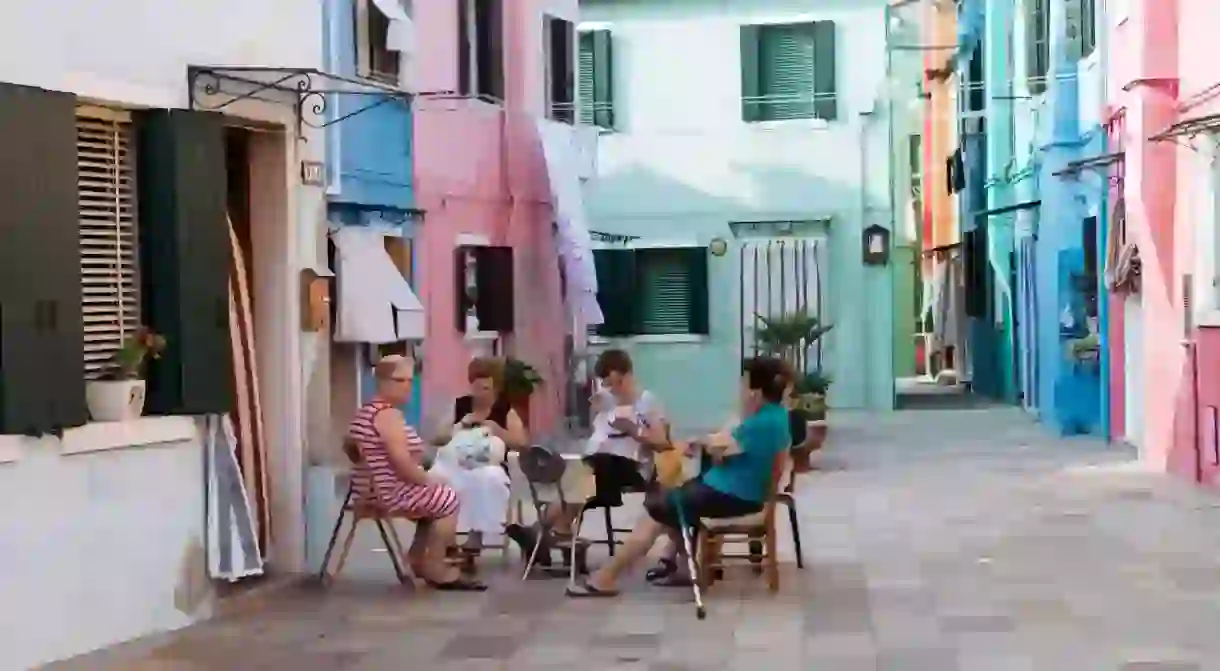An Introduction to the Lace Makers of Burano

Burano’s beautiful, coloured houses often hog the spotlight when one thinks of Venice’s most famous island, but it is the needle lace of the Renaissance period that Venice – Burano in particular – became famous for. Find out why this historic method still thrives today on the island.
Origin
Visitors to the archipelago today can still buy beautiful and intricate lace fabrics created using the same historic method passed down through generations of the islands’ female residents. While the highly-elaborate, yet delicate needle designs from Venice no longer maintain the exclusive reputation they held in 17th-century Europe, for many of the island’s female inhabitants, lace making remains a way of life.
History
In the 16th century, Venetian needle lace making was an elevated artform produced by noblewomen in the privacy of their own homes. While bobbin lace became professionalised in other areas of Italy in the 17th century, other European nations struggled to emulate the women of Burano‘s intricate designs, and their signature stitches were recognised in the banquet halls and courts across the continent.
Baroque lagoon lace in Venetian Gros point embossed leaf design was so beautiful and highly sought after that the court of King Louis XIV in France employed several Venetian lace makers to teach their skill and facilitate home manufacturing. In the following centuries, Venetian lace fell out of demand, as it had to compete with cheaper manufactured products and fashion trends. For example, in the 18th century it was in competition with Flemish and French design.



Growth In Populatiry
The 19th century saw Italian intellectuals, politicians and influential aristocratic ladies work to return Venetian craftsmanship to its elevated position on the market – they campaigned for its recognition as an archaic artisanal product. These efforts reinvigorated production in Burano, but in the 20th century it once again fell victim to changes in trends.



Continuity In Tradition
Since then, lace production in Burano has lived on as a cherished, traditional artform rather than as a viable commercial trade product, with tourism being the main market. Burano lace is still internationally esteemed, and many tourists visiting Venice make a point of stopping at Burano to shop. Despite the fact that much of the lace is now also machine produced, handmade items are still created exclusively by the islands’ female residents. If you spend enough time in Burano you will spot them seated in a shop front or doorway quietly crafting. Most of these women are driven by a passion for the craft and a desire to preserve the local heritage, and will have learned their trade from their mothers and grandmothers or at the prestigious lace-making school ‘Scuola di Merletti’ established in 1872.


Experiences
When Culture Trip photographer Chiara Dalla Rosa visited Burano, she spent time speaking to the lace makers about the craft and its place in the future. As she recalled, “A group of women I spoke to were retired, yet lace making remains the centre of their social activity on the island. They were sitting together outside crafting, chatting and gossiping the evening away. They have a small box of items available for sale to passers by, but this seemed almost redundant to the joyful act of lace-making itself.
“I was amazed to discover that up to seven women would work on one creation. They all know the fundamental craft but then they each specialise in a different technique required to complete more complex lace pieces. They expressed passion for their craft and light-heartedly lamented about the difficulty of inspiring interest in lace making in Burano’s younger generations of women.”



Preserved Works
Precious and historically significant lace works are on display at the Burano Lace Museum, but some of the old shops (or rather emporiums) are more thrilling: rows of neatly-pressed tablecloths, hung blinds and blouses, and drawers of delicate handkerchiefs. Pictorial and narrative designs are typically framed creating artworks for the wall.
Did you know – Culture Trip now does bookable, small-group trips? Pick from authentic, immersive Epic Trips, compact and action-packed Mini Trips and sparkling, expansive Sailing Trips.













